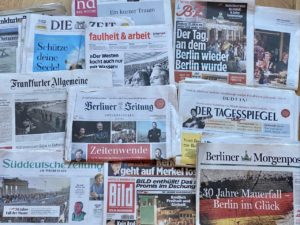THE ROLE OF CIVIL SOCIETY IN TRANSITION TO DEMOCRACY
Examples from Bulgaria, Germany, Poland, Lithuania, and Ukraine
Authors: Alicja Pacewicz, Olena Pravylo, Leonie Sichtermann, Louisa Slavkova & Giedrė Tumosaitė
I. Overview
The lesson plan outlines a working definition of civil society and its role in a healthy democracy. It focuses on three pillars: 1) civil society in times of a totalitarian regime, 2) civil society and its role during a period of change – the end of a totalitarian regime and the beginning of a transition to democracy, 3) civil society today and its value for a resilient democracy.
II. Objectives
- Describe the role of civil society.
- Be in a position to compare different civil society movements before, during and after the transition to democracy in different countries.
- Be able to identify the challenges and opportunities for civil society in the present – on local, national, and transnational levels.
III. Key concepts
Civil society: “Civil society refers to all forms of social action carried out by individuals or groups who are neither connected to, nor managed by, the State.”1
Civil society organizations (CSOs): “A civil society organization is an organisational structure whose members serve the general interest through a democratic process, and which plays the role of mediator between public authorities and citizens. Examples of such organizations include social partners (trades unions & employers’ groups); non-governmental organizations (e.g., for environmental & consumer protection); grassroots organizations (e.g., youth & family groupings). The European Economic and Social Committee represents civil society at EU level.”2
Non-governmental organizations (NGOs): Sometimes civil society is mistaken for non-governmental organizations (NGOs) only. NGOs are legal entities regulated mainly by a special Non-Profit Legal Entities Act in any country. They are independent of the government and the private sector and are not working for profit; they are guided by certain goals and values set out in their statutes. Such a goal can be to support society as a whole or some of its individual groups (parents, children, artists, minority groups, journalists, etc.).
Active citizenship: “Active citizenship means people getting involved in their communities and democracy at all levels from local to national and global. An active citizen promotes the quality of life in a community through both political and non-political processes developing a combination of knowledge, skills, values and motivation to work to make a difference in the society.”3
Totalitarianism: “Totalitarianism is a form of government that attempts to assert total control over the lives of its citizens. It is characterized by strong central rule that attempts to control and direct all aspects of individual life through coercion and repression. It does not permit individual freedom. Traditional social institutions and organizations are discouraged and suppressed, making people more willing to be merged into a single unified movement. Totalitarian states typically pursue a special goal to the exclusion of all others, with all resources directed toward its attainment, regardless of the cost.”4
Pluralism: “Pluralism, in political science, the view that in liberal democracies power is (or should be) dispersed among a variety of economic and ideological pressure groups and is not (or should not be) held by a single elite or group of elites. Pluralism assumes that diversity is beneficial to society and that autonomy should be enjoyed by disparate functional or cultural groups within a society, including religious groups, trade unions, professional organizations, and ethnic minorities.”5
Key questions
- Can civil society exist in a totalitarian regime and, if so, how?
- What role does civil society play in times of transition to democracy?
- Why is civil society important for a functioning democracy?
IV. Step-by-step description of the lesson
Introductory words: Why focus on the role of civil society?
The idea that a dynamic, active, and independent civil society is crucial to the health of any democracy, has gained momentum in the last century, even more so after the fall of the Berlin Wall and the end of communism in Eastern Europe.
It is a key feature of totalitarian states, such as Bulgaria, Lithuania, Poland, or Ukraine before 1989/91 that the ruling regime puts under total control all spheres of human life and there is practically no space for people’s own initiative or organization outside the structures of power. This, indeed, is the situation within the extreme form of totalitarianism, but various subcultures, underground movements, and, sooner or later, forms of civil protest and disobedience emerge even under the most oppressive regimes.
The attacks seen in recent years in many countries around the world against CSOs that criticise their governments or denounce abuses of power show that non-democratic leaders see civil society as a threat to their existence. We deem it important to point out the power of the citizens and civil society to effect change and help democracies to flourish. That is why we chose to develop teaching materials that focus on the historical role of civil society for the process of transition to democracy in post-communist countries in Eastern Europe. The lesson plan is split into three units: unit I deals with civil society before 1989/91 in communist Europe; unit II explains civil society in the transition period after 1989/91; and unit III examines civil society today and outlines why it is important to get involved.
UNIT I: “CIVIL SOCIETY BEFORE 1989/91 IN COMMUNIST EUROPE”
Materials: sticky notes, white board, markers, pre-printed photos, a screen that everyone can watch and internet.
Beginning of the lesson: Give some introductory remarks to your students explaining that this part lesson consists of three parts: 1) civil society under communism, 2) civil society in times of transition to democracy and 3) civil society today.
ACTIVITY 1: Analyse quotes – Who represents civil society under a totalitarian regime? (15 minutes)
🎯 Aim: Have a basic understanding of who represents civil society under a totalitarian regime and what form civil society takes in this context. Learn the distinction between genuine civil society and civil society organized by the state.
🗒️ Description: Ask your students to listen to or read two quotes (see APPENDIX – SOURCE A) and answer the following questions:
- Who represents civil society according to the speaker’s statements? List as many examples as you can find.
- What does the speaker mean by “all these groups which were organized by the Party and that would not really count as civil society”?
ACTIVITY 2: Analyse pictures and relate to what has been learned in activity 1 – The main actors and functions of civil society [10 minutes]
🎯 Aim: Learn to identify who the main actors of civil society are under a repressive regime (in comparison to a democratic state) and what the functions (confrontation and resistance rather than cooperation) of civil society are. Understand how they differ in comparison to a democratic context.
🗒️ Description: Split the class into groups and provide each group with markers, paper (a different color for each group) and a set of pictures (see APPENDIX – SOURCE B: Picture SET I). Ask the students to take 5 minutes to look at the picture and describe what they see. Once the 5 minutes are over, hand out a second set of pictures (see APPENDIX – SOURCE B: Picture SET II). The pictures represent different civil society actors from different country contexts (Bulgaria, Germany, Lithuania, and Ukraine). While set I represents the “fake” civil society organized by the regime, set II represents the genuine civil society and protest actions.
Let each group nominate a person that will take notes and present the results of the group. Students should answer the following set of questions:
- What do you see on the pictures? Be as specific as possible (which country, city, year, event, participants, etc.). What are the people doing? What do they look like? Are they representatives of civil society?
- Relate the pictures to the homework and describe which are the pictures representing genuine civil society, which do not and why. Describe the characteristics of both. Use sticky notes in two different colors.
In a next step, invite the note-takers to share on the whiteboard the following clusters of information:
- Who were the civil society representatives before 1989/91?
- How were they organized?
- What were they doing? Gather the class together again. First, ask the respective note takers to describe what the group observed on set I and set II of the pictures. Afterwards collect the sticky notes on a board. Summarize the characteristics of both.
UNIT II: “CIVIL SOCIETY IN TIMES OF CHANGES”
Materials: pre-printed material, sticky notes, white board, a screen that everyone can watch, computer, projector, and internet.
Beginning of the lesson: Recapitulate what has been discussed in unit I regarding civil society. Explain, that this unit will deal with the role of civil society during the processes of change in Eastern Europe after 1989 and the fall of the totalitarian regimes.
ACTIVITY 1: The transition of 1989: from … to … ? (15-18 minutes)
🎯 Aim: To consolidate the learning outcomes of the previous unit. To reflect upon the reasons that brought people to the civil movements and protests in the early 1990s.
🗒️ Description: Each student receives one quote (see APPENDIX – SOURCE C). Ask students to read the quote individually and write down, in their own words, 1-2 reasons that were important factors in starting the massive changes in the countries of Central and Eastern Europe in 1989.
Split students into the groups according to the quotes received (approx. 4-5 students in a group). Ask students to discuss and agree on 1 or 2 reasons to be presented to the rest of the class. Each group appoints a note-taker that will report the results of the group to the rest of the class. The note-takers of each group present the results of the group providing a very brief justification for their choices. Other groups can react briefly. Wrap up the discussion, provide your feedback.
ACTIVITY 2: Triumph of the civil society (15-18 minutes)
🎯 Aim: To understand the role that civil society played at the beginning of the transition period and its contribution to the changes. To understand the diversity and uniqueness of each country’s experiences and situation.
🗒️ Description:Show students a video created by Radio Free Europe (see APPENDIX – SOURCE D). Since students are already working in the groups, ask each group to come up with their own title for the video. Ask 3 groups to present their title and explain why they have chosen it. Collect feedback from other groups. Choose one of the following questions to discuss with the students:
- Why is the sequence of the events of 1989 in post-communist and post-Soviet regions often called a “domino effect”?
- How can you define the role of civil society in the events of 1989?
UNIT III: “CIVIL SOCIETY TODAY. WHY GET INVOLVED?”
Materials: sticky notes, white board, a screen that everyone can watch and internet.
ACTIVITY 1: Imagine that you are living in a country where you are not allowed to establish an NGO or organize a demonstration (15 minutes)
🎯 Aim: To imagine/visualize a political system where civil society does not exist, is banned, or repressed and to judge the consequences for democracy and society.
🗒️ Description: Referring to previous activities, ask students what they think life in their country would be like now if civil society had not taken to the streets 30 years ago in protest against the communist regime. What countries in the world still have a totalitarian regime and what is public life like there? If students are lacking information, ask them to find out about the civil society situation in countries such as Cuba and North Korea on the web or briefly describe them yourself. Explain that there are other countries, such as Turkey, Syria, China, Hong Kong, and Nicaragua, where civil rights are systematically curtailed, and civic movements and organizations repressed. You may also refer to the political situation in Belarus and the brutal repressions on the civil society movements after the rigged presidential elections in 2020 (see APPENDIX – SOURCE E.a).
Now suggest that everyone tries to imagine what their life would be like in a country where citizens do not have political rights, cannot associate, express their views freely and act without the permission of the authorities. Ask them to recall the titles of books or movies that are set in such places (see APPENDIX – SOURCE E.b for inspiration). Note that many of today’s series, especially political fiction, and science fiction, also portray a collapsing democracy and the birth of totalitarian systems in which citizens lose their political as well as personal rights and freedoms. This is the world presented, for example, in the British series “Years and years”. You can watch the trailer for this series or its short film review (see APPENDIX – SOURCE E.c).
Ask everyone for a moment to imagine that also in your country, constitutional democracy is slowly starting to deteriorate, and the authorities are introducing a ban on association and independent public assembly. Discuss:
- How do students feel about these images?
- What can citizens do in such a situation?
- What do you think most people will do?
- How will you behave yourself?
- What could be the consequences of such behavior?
Note: you can suggest that they answer this question using a teaching aid such as Mentimeter6 or a similar e-tool.
ACTIVITY 2: What do civil society organizations actually care about? In what areas of life are they active in our country and elsewhere? (10 minutes)
🎯 Aim: To sketch a general image of the diverse areas of work and actions of civil society organizations.
🗒️ Description: Display the slide(s) (see APPENDIX – SOURCE F) with graphic materials on the interactive board, illustrating the various areas of activity of community organizations. As it is in Polish (see English explanations below), first ask the students to try to guess which fields of activity each of the pictures relate to. Explain that the illustration in the lower left corner is the hashtag of the campaign “Civil Society Organizations. It works!”, promoting the activity of non-governmental organizations in Poland and building awareness of how many different problems of social, political, and cultural life they deal with on a daily basis. Although this graphic illustration concerns Poland, the categories included in it match the activities of organizations and civic movements in most countries.
Ask to illustrate the different areas of action with examples from your town or country. Also check if students would like to add any area of life or a problem that is dealt with by a known organization. Match it to the aforementioned categories or, if necessary, create a new one.
If students do not address the pandemic in any way, note that COVID-19 has proved to be a tough test for human and social rights, democratic values, the rule of law in all our countries and that almost everywhere civil society organizations played an important role during the pandemic. They will also be important players in the recovery and resilience of societies in the coming years.
ACTIVITY 3: Case studies from our own countries (20 minutes)
🎯 Aim: To analyse an example of a civil society activity/action with a special focus on emancipatory/equal rights movements (examples can be found on transition-dialogue.org), to think about the role of progressive ideas in post-communist societies.
🗒️ Description: Now pose an open question to the class on why active citizenship is weaker in post-communist countries than in countries with a longer democratic tradition. What could this be the result of? Membership in associations is not common here, sometimes it is even elitist and becomes only an element of political culture. Today, social media facilitates the communication and interaction of citizens, but this role is still limited.
Ask students to provide some examples of civic activities, including protests in recent years.
Choose an example of a civil movement from your country in the area of equal rights (e.g., women’s rights, minorities’ rights) or other progressive ideas (e.g., ecology, climate change). Based on the students’ previous knowledge, analyse the selected movement according to the following questions: a) what were they about, b) what caused them, c) who were their leaders, d) what are the effects of their protests, social campaigns, and other activities? The teacher may also propose an analysis of a civil movement from another country, e.g., the protests organized in autumn 2020 by Women’s Strike in Poland.
As part of the analysis of the case, ask the students to think of one important question they would like to ask of someone who participated in those activities. Students can share their ideas for questions and the volunteers can later choose some of them, edit them, and send them to the activists through social media. If the teacher is ready to devote more time to the topic of civil society, he/she can also let students invite such individuals to participate in the lesson (e.g., online). As an extra task, volunteers can conduct face-to-face interviews with activists.
Consider together whether the organizations and movements opposing the mainstream political, social, or cultural order play a positive role in democracy and society, or only disturb the social order (or at least – street traffic…). Why do new social movements arouse so much emotion in traditional societies? Should, for example, governments of individual countries or the European Union authorities support them?
ACTIVITY 4: What do we need civil society for? What are its functions in our own country? Can democracy live without civil society? (15 minutes)
🎯 Aim: To investigate the potential functions of civil society and its institutions for democracy in our own countries and elsewhere.
🗒️ Description: Write down on the board (regular or interactive) the question: What do we need civil society for? Ask young people, working in teams of three or four, to talk for a while about the functions of civil society organizations, activities, and impact in democratic countries or on the road to democracy. Then give students the text of Larry Diamond’s speech at the What Civil Society Can Do to Develop Democracy Leader Meeting (SOURCE D) and ask them to jointly list the features that the author mentions. Compare the lists composed by all the teams. Are these functions also important in our country – today and in the future?
ACTIVITY 5: Ideas for young people from student localities to get involved in CS actions or to establish their own association or action – teamwork (20 minutes)
🎯 Aim: To motivate students to develop their own project ideas and to get actively involved in civil society.
🗒️ Description:Ask students what community organizations they have participated in or have benefited from in the past – themselves, their friends, family, or school. Explain that the scenarios were developed by NGOs from seven countries participating in the Transition Dialogue joint educational program.
Now suggest that everyone think for a moment what types of activities are closest to them and what they would like to get involved in over the coming weeks or months. Ask everyone to write their ideas on 1-2 sticky notes, then stick them on the board and organize them together, grouping similar ideas together (the same activity can be carried out using an interactive whiteboard or an e-tool like Jamboard7).
Divide the students into small teams based on their interests for similar topics and ask them to think together about what steps they should take now in order to actually engage in a civic initiative in the chosen area. Encourage cooperation in this group after classes too – suggest that each student take on a small task related to it, for example, searching the network for contacts to local organizations, their activists, current or planned activities, and checking how young people can take part in these activities. Explain that they can also plan their own community action (or even set up an association) on an issue that interests them – for example, student rights, protecting trees from being cut down, or caring for homeless animals in their locality.
Note that some of the problems students want to deal with not only affect their local community, but often the entire country, and even Europe or the world (e.g., climate, environment, exclusion, inequality, and xenophobia. So, students can also plan to engage in a wider initiative – for example, a campaign or civic action carried out on a European or even global scale (such as the youth climate movement Fridays for Future8). Mention volunteer work – special portals for finding such offers can help you search for opportunities9. Ask students to consider why some people believe that there is no real modern democracy without volunteering?10
Summary
Invite students to write down one thought and one question that came up in their heads during class on a post-it note, and to post it in a prominent place as they leave the classroom. Read them carefully and use them as feedback and material for further work with the class.
APPENDIX
SOURCES – Unit I
SOURCE A: Quotes
Quotes by Christoph Eichhorn, German diplomat. The quotes are part of a discussion (histoTALK) on the particular role of civil society at the end of a totalitarian regime and the beginning of the transition to democracy.11
Quote 1:
“A democracy without democrats does not work and democrats means democratic parties organized in a democratic parliament, voting in a government, and voting it out, but also democrats in the general public who are deeply convinced about the importance of democracy – all of it was not there in Germany until 1945.12 To a certain extent it was there, but very very limited. […] East Germany from 1945 to 198913 was another totalitarian regime, another dictatorship, a communist ruled system. There was no such thing as civil society. Society was organized in all sorts of groups depending on the one Communist Party and whatever the Communist Party ordered these so-called groups in society implemented and executed. But this has nothing to do with a civil society in a free democratic country.” [min. 08:50 – 10:21]
Quote 2:
“I think we can discuss our joint – German, Bulgarian, Hungarian, Polish, Czech, Baltic, Ukrainian etc. experience, our joint experience, throughout the night. If we have one word where it all comes down to then it is the word freedom. And the point I would like to make is… you know, when I walk through the Brandenburg Gate14 in the middle of Berlin, this is the symbol of freedom denied, freedom lost, and freedom regained in 1989. The point I´d like to make is this: sometimes in our discussions we question (you know) was all of this a big illusion. Were we dreaming of paradise 30 years ago and look where we are now? So much more difficult, so many illusions gone. And I would argue that we have to sort of reconsider the fundamental element of what we are talking about here and that is freedom. The fact that things take longer or that there are setbacks or that there are illusions that certainly bust, does not mean that the fundamental importance of freedom is an illusion or that we should stop investing in it. This is fundamentally important. When you are looking at the East German experience; I mentioned earlier all these groups which were organized by the Party and that would not really count as civil society. But at the same time, you had people writing songs, you had people working to improve the environment where they lived, you had people doing Samizdat15, you know, writing down the stories which their parents and their grandparents were telling them and circulating them, writing it themselves and circulating them to their friends. So, all of this existed despite the fact that the larger system was a repressive system. So, the fundamental desire of every human being to be free was always there and will always be there.” [min. 37:52 – 40:41]
SOURCE B:
Pictures SET I: A “fake” civil society organized by the regime
- Lithuania – May 1st parade
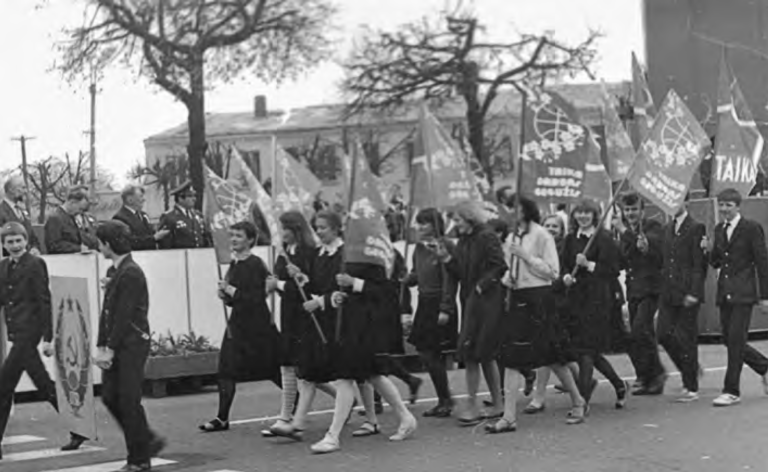
Photo by Vincas Tumosa (private)
- Poland – 1st May celebration in the city of Wrocław in 1982
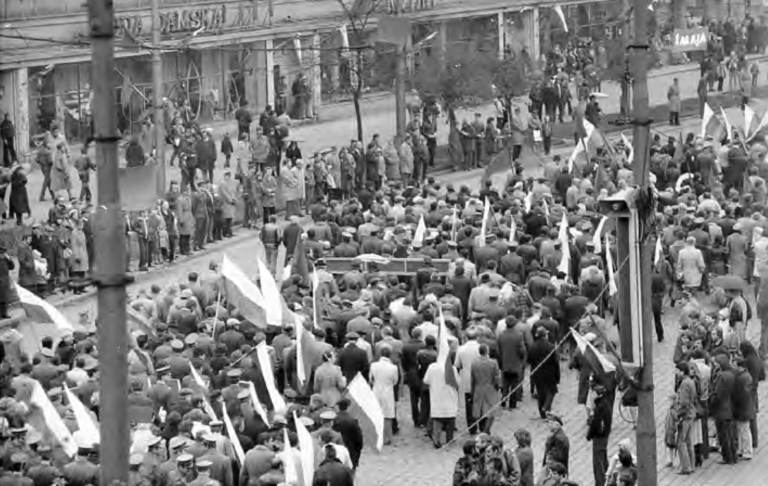
Credits: Julo, Public domain, via Wikimedia Commons.
Source: https://commons.wikimedia.org/wiki/File:Wroclaw1maja1982.jpg
Pictures SET II: genuine civil society and protest actions
- Bulgaria – The first civic protest organized in Ruse in 1987 against air pollution coming from the Verahim plant in neighboring, thencommunist Romania
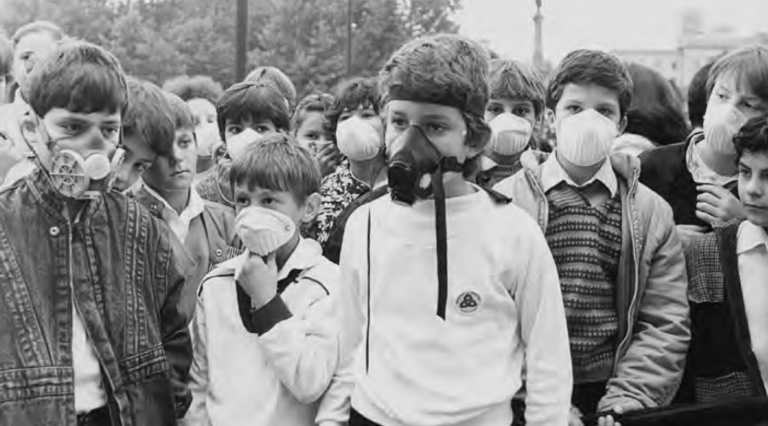
Credits: State Archive Ruse, source: socbg.com.
- Participants of the strike at the Gdańsk Shipyard Lenin in August 1980
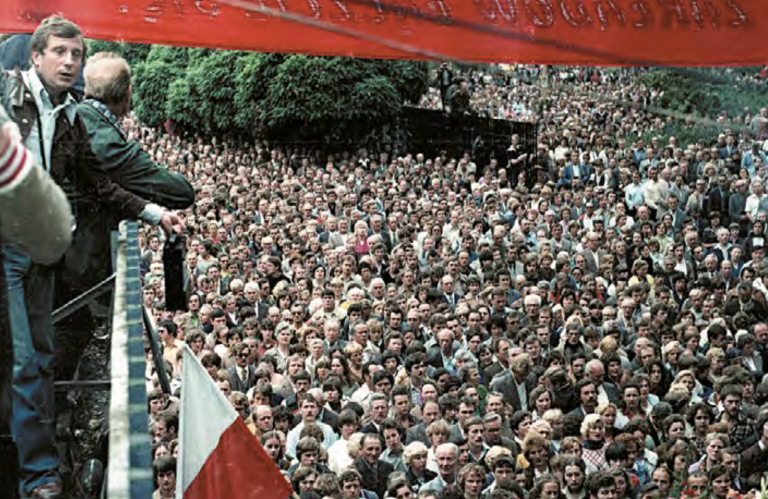
Photo by Zygmunt Błażek. Credits: European Solidarity Centre, under a CC BY-SA 3.0 PL license via Wikimedia Commons.
Source: https://histmag.org/grafika/2016_articles/skorzynski/solidarnosc4.jpg.
SOURCES – Unit II
SOURCE C: Quotes
Quote 1:
1989 represents a break-away of the entire region of Europe from political oppression and a leap towards democracy. On the other side of this spectrum is the meaning of 1989 as the promise of western standards of living that tipped a resistance movement of intellectuals and dissidents towards a mass protest movement. […] It can be argued that the person who strived for civil liberties and the person who wanted better jeans are not necessarily two different people. What is common to both of them is self-determination, which comes in plural and diverse forms. Thus, 1989 can be viewed as a resistance to endless intervention of politics into the lives of citizens, when governments decide how one can get married, what songs to sing, or how much flour or sugar one can receive.
(Simona Merkinaite. What 1989 can (and cannot) teach us, New Eastern Europe, 2021)
Quote 2:
1989 symbolizes the limits of attempting to endlessly reshape and remake society and reattributing the meaning to prosperity, which in reality meant deficiency when a lack of choice meant freedom, military invasion. In 1989, the reality of lived experiences prevailed over ideology and fiction. Seen in this light, the year 2020 became a point of “1989 reoccurrence”, through a new wave of mass revolts against political fictions. The outrage of people in Belarus was sparked by the outrageous lies about the free democratic election and the blunt attempts to conceal the almost universal support for Alyaksandr Lukashenka. The commonality between the workers, students, women, and pensioners’ protests is the shared feeling of having enough of living a double life – the private life of isolation, repression, and shortage versus the performative public life of happiness, freedom and community. Simona Merkinaite. What 1989 can (and cannot) teach us, New Eastern Europe, 2021).
Quote 3:
Documentary project created by the Public Interest Journalism Lab (UA) about the protests of Ukrainian miners in 1989 “Чуєш гуркіт касок?”16
Quote 4:
In August 1989, the three Baltic states were still under Soviet rule. On August 23rd, 1989, inhabitants of the three countries decided to make their wish for independence heard by joining hands [in a human chain of more than 600 km]. Euronews spoke to Andres Kasekamp, a professor of Estonian studies at the University of Toronto, about the historic event. “The people behind the event were the leaders of the Estonian People’s Front and they did this together with Latvian and Lithuanian colleagues. It was a magnificent display of Baltic cooperation amongst the three peoples. It was very important to send a signal to the world because the narrative from Moscow about the Baltic movements of freedom, democracy, and eventually independence was that it was only a small fringe group of extremists, nationalists, who wanted independence. But with this chain across all three countries, it was clear that narrative that Moscow was trying to convince the world […] was simply not true. This reflected the desire of the vast majority of the people.”
(Cristina Abellan Matamoros. Baltic Way: 30 years since the 600km human chain that helped trigger the collapse of communism, 2019).
Quote 5:
“In the 1980s in Poland, if you asked people why they are engaged in civil movements – they would not answer that they are fighting for liberal democracy. I personally do not recall any debates about liberal democracy as a model … It was pluralism, that was a remedy against ideology in the ‘80s and the real power of the democratic movements in ‘80-‘81 and then 1989, the intrinsic belief in pluralism; but, as it turns out, it is not an easy lesson to learn. I would say that pluralism is the challenge of our time – it is hard to imagine the West without pluralism,” – Professor Marek Aleksander Cichocki, philosopher, editor-in-chief of Teologia Polityczna.
(Simona Merkinaite. What 1989 can (and cannot) teach us, New Eastern Europe, 2021).
SOURCE D: Videos
Video: End of Communism: How 1989 Changed Europe – Click to watch
Additional sources:
– Radio Free Europe, The Revolutions of 1989 – Click to watch
SOURCES – Unit III
SOURCE E: Civil society in totalitarian regimes today
SOURCE F: Activities of community organizations
Quote 3:
Activities of civil society organizations17
- We are building a community – Budujemy wspólnotę
- We protect the climate – Chronimy klimat
- We help each other learn – Pomagamy się uczyć
- We protect health – Ratujemy zdrowie
- We make connections – Łączymy
- We develop passions – Rozwijamy pasje
- We defend rights – Bronimy praw
- We create culture – Tworzymy kulturę
- #it works – #to działa
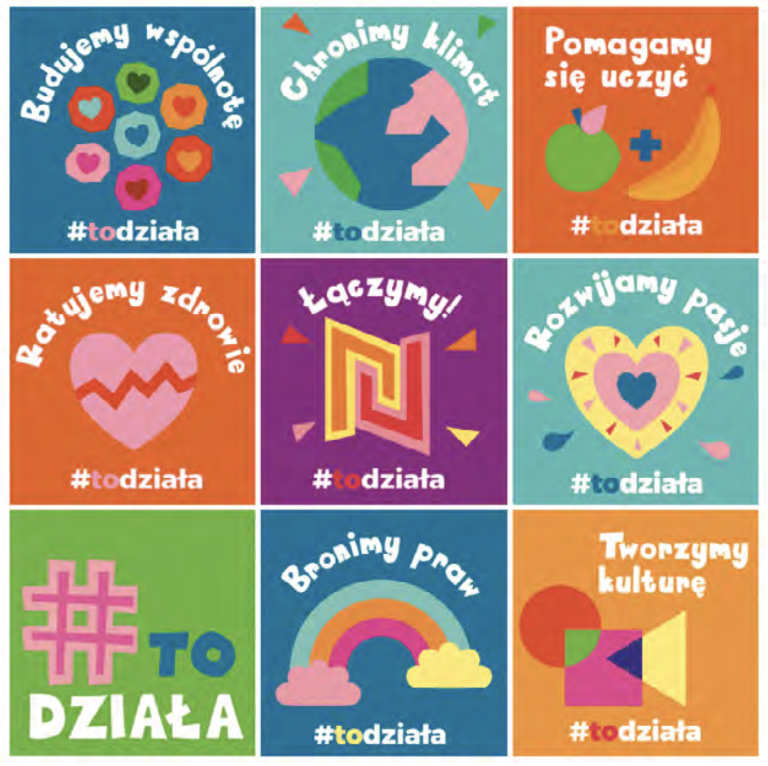
Footnotes
- EUR-Lex – Access to European Union law: ‘Glossary of summaries – Civil Society Organisations’. Available at: https://eur-lex.europa.eu/summary/glossary/civil_society_organisation.html. A very thorough description of the concept is available here: https://en.wikipedia.org/ wiki/Civil_society: Civil society can be understood as the “third sector” of society, distinct from government and business, and including the family and the private sphere. By other authors, civil society is used in the sense of 1) the aggregate of non-governmental organizations and institutions that manifest interests and will of citizens or 2) individuals and organizations in a society which are independent of the government. Sometimes the term civil society is used in the more general sense of “the elements such as freedom of speech, an independent judiciary, etc, that make up a democratic society” (Collins English Dictionary). Especially in the discussions among thinkers of Eastern and Central Europe, civil society is seen also as a normative concept of civic values.
- Ibid.
- European university college Association (EucA): ‘Active citizenship’. Available at: https://www.euca.eu/activecitizenship
- Britannica (2021): ‘Totalitarianism’. Available at: https://www.britannica.com/topic/totalitarianism
- Britannica (2008): ‘Pluralism’. Available at: https://www.britannica.com/topic/pluralism-politics
- See at: https://www.mentimeter.com/features/word-cloud
- See at: https://jamboard.google.com/
- Information available at: https://fridaysforfuture.org/
- In the EU many offers can be found at https://europa.eu/youth/go-abroad/volunteering/ opportunities_en
- See for example: Ukraine World (2019): ‘Why Ukraine would not be European without Volunteers?’. Available at: https://ukraineworld.org/articles/ukraine-explained/why-ukrainewould- not-be-european-without-volunteers
- The full discussion is available at: https://www.facebook.com/SofiaPlatform/ videos/2936072426612483
- 1945 marks the defeat of Germany in World War II (1939-1945) and the end of the Nazi dictatorship.
- At the end of World War II, in 1945, Germany was divided into the Western Federal Republic of Germany (FRG) and the Eastern German Democratic Republic (GDR). The latter was ruled under a communist dictatorship till the reunification with Western Germany in 1989/90.
- The Brandenburg Gate is an eighteenth-century neoclassical monument, located in the centre of the German capital, Berlin. Being a site for many major historical events it is today considered as both a symbol of the turbulent history of Europe and Germany and of European unity and peace.
- Samizdat was a form of dissident activity across the former Eastern Bloc countries, in which individuals reproduced publications censored by the Soviet dictatorship. This often happened manually because most typewriters or printing devices required permission to access which was only granted by the Soviet forces. The written documents were then passed from reader to reader.
- Available at: https://www.youtube.com/watch?v=cyzpiY7md6k (min. 02:13 – 05:23).
- Available at: https://publicystyka.ngo.pl/swietuj-z-nami-dzien-organizacji-spolecznych

